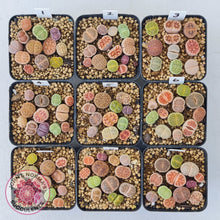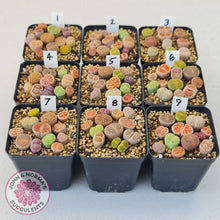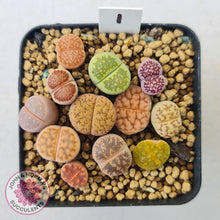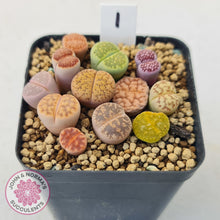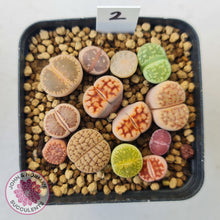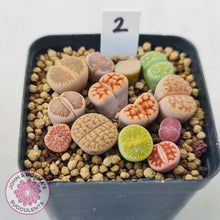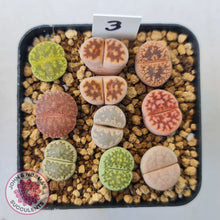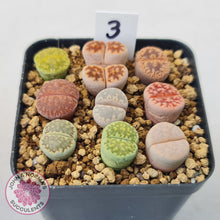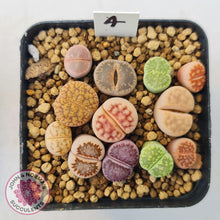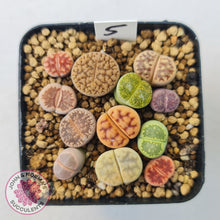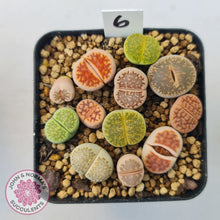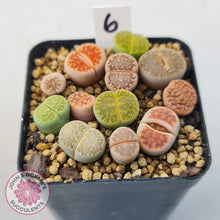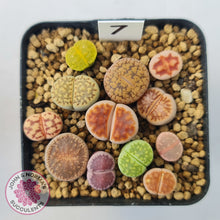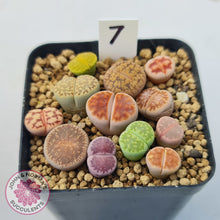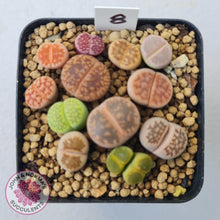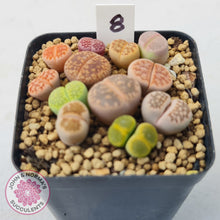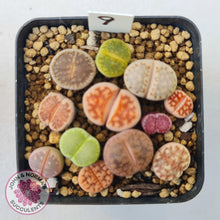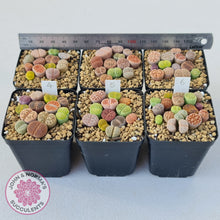
Lithops mixed hybrid varieties for sale shown in 55mm pot. You will receive same plants as those shown in images. All are mixed hybrids in different colours.
Please select pot number from drop down menu. If still in stock you will be able to purchase and receive the same plants as shown in image displayed with chosen option. If you are unsure of plant size, please check plants against ruler shown in last image,
Please Note: These lithops mixed hybrids are mostly well rooted. The odd one may have small roots as it is difficult to check them all. They will be shipped with pot and soil included. What you see is what you will get. They will be carefully packed so as not to disturb them. Of course when you get them you can re-pot or separate them and replant however you wish.
Unearth the Wonders of Lithops: Nature's Masterpiece of Mimicry and Survival
Lithops, affectionately known as "living stones" or "stone plants," are captivating succulent specimens native to the arid landscapes of southern Africa. Boasting a truly distinct morphology, these diminutive plants are formed of two thick, fleshy, and semi-translucent leaves that uncannily resemble stones or pebbles. Each pair of leaves converges at ground level into a single taproot-like structure, acting as the plant's foundational root system.
One of the most captivating features of Lithops is the "leaf window"—a flattened, translucent top surface that enables effective photosynthesis. This botanical marvel features intricate patterns and vibrant hues, each specific to the individual species.
Unique among succulents, Lithops have a particularly specialized flowering cycle that aligns with noon in the southern hemisphere. Their solitary blooms erupt from a short stem and can range from ethereal whites to radiant yellows. Post-flowering, these enigmatic plants produce hydrochastic seeds—seeds designed to open upon contact with moisture, thereby allowing for dispersion via raindrops.
As resilient as they are intriguing, Lithops can endure extreme temperatures ranging from above 42°C down to as low as -5°C. They flourish in a myriad of environments—from quartzite terrains to arid, stony slopes, and even open grassland patches.
Cultivating Lithops presents an enjoyable challenge for succulent aficionados. These plants thrive in well-drained soil and demand judicious watering. In temperate climates, it's advisable to let them dry out completely during winter, only resuming watering when a new set of leaves has fully replaced the old pair. In hotter climates, occasional winter watering paired with a summer dormancy period keeps them healthy.
Among the plant’s most spellbinding adaptations is its knack for camouflage. The fenestrated leaves display a tapestry of creams, greys, and browns, often accentuated with dark window-like patches, dots, or red striations—meticulously mimicking their stony backdrop.
Pollination in Lithops is another subject of botanical intrigue. They are obligate outcrossers, which means they require pollen from a different Lithops plant for fertilization. Bumblebee-like insects and possibly moths generally take on the role of pollinators during the late afternoon and early evening hours.
In extreme cases of drought, Lithops showcase their ultimate survival mechanism: they have the ability to retract into the soil, becoming semi-subterranean to minimize moisture loss.
In summary, Lithops serve as both a botanical wonder and a testament to nature's ingenuity. Their unparalleled aesthetics and remarkable survival adaptations make them an unmissable addition to any succulent collection.
First time customers... Please read our Shipping Guide, in top or bottom menu, before placing your order.
Please Note:
- These plants will be sent with soil and pot included.
- What you see is what you will get.
- All plants are well rooted.
- We will try to avoid plant disturbance as much as possible during shipping.
- We would appreciate your feedback on how well they shipped.
If you have any questions or concerns at all, before or after shipping please message us.





















